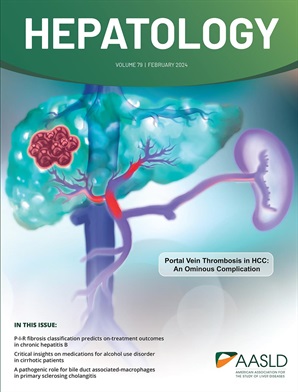NEK7 induced phosphorylation of EGFR on serine 1070 drive the acquired lenvatinib resistance in hepatocellular carcinoma.
IF 15.8
1区 医学
Q1 GASTROENTEROLOGY & HEPATOLOGY
引用次数: 0
Abstract
BACKGROUND AND AIMS Lenvatinib is recognized as a first-line therapy for inoperable hepatocellular carcinoma (HCC) patients. Growing evidence indicates that the lenvatinib resistance can be acquired in HCC cells via kinase rewiring. APPROACH AND RESULTS We established acquired lenvatinib resistance organoids and HCC cell lines. NIMA-related coiled-coil kinase 7 (NEK7) was identified as an HCC lenvatinib acquired resistance gene by kinase CRISPR-Cas9 genetic screen. Functional analyses demonstrate that NEK7 enhanced lenvatinib resistance in HCC and NEK7 knock down or knock out display the anti-tumor effects in acquired lenvatinib HCC cells and organoids. Mechanistically, NEK7 binds to EGFR, leading to the phosphorylation of EGFR (Endothelial growth factor receptor) specifically at the serine 1070 residue, which contributes to the activation of MAPK (Mitogen-activated protein kinase) and PI3K/AKT (Phosphoinositide 3-kinase/Akt) signaling pathways. Consistently, designed inhibitory peptides targeting domain from amino acids 979 to 1099 were proved to inhibit phosphorylation of EGFR S1070 site and therapeutically inhibit anti-tumor of acquired lenvatinib resistance HCC. CONCLUSIONS Our results unveil insights into the acquired lenvatinib resistance mechanism that NEK7 phosphorylates EGFR at S1070 to promote acquired lenvatinib resistance in HCC.NEK7诱导EGFR在丝氨酸1070上的磷酸化驱动肝癌获得性lenvatinib耐药。
背景和aimslvatinib被认为是不能手术的肝细胞癌(HCC)患者的一线治疗药物。越来越多的证据表明,lenvatinib耐药性可以通过激酶重新布线在HCC细胞中获得。方法与结果建立获得性lenvatinib耐药类器官和HCC细胞系。通过激酶CRISPR-Cas9基因筛选,发现nima相关的卷曲激酶7 (NEK7)为HCC lenvatinib获得性耐药基因。功能分析表明,NEK7增强了lenvatinib在HCC中的耐药性,NEK7敲低或敲除在获得性lenvatinib HCC细胞和类器官中显示出抗肿瘤作用。从机制上说,NEK7与EGFR结合,导致EGFR(内皮生长因子受体)特异性磷酸化丝氨酸1070残基,这有助于激活MAPK(丝裂原活化蛋白激酶)和PI3K/AKT(磷酸肌肽3-激酶/AKT)信号通路。同样,设计的979 - 1099氨基酸区域抑制肽被证明可以抑制EGFR S1070位点的磷酸化,并在治疗上抑制获得性lenvatinib耐药HCC的抗肿瘤作用。我们的研究结果揭示了NEK7在S1070位点磷酸化EGFR促进HCC获得性lenvatinib耐药的机制。
本文章由计算机程序翻译,如有差异,请以英文原文为准。
求助全文
约1分钟内获得全文
求助全文
来源期刊

Hepatology
医学-胃肠肝病学
CiteScore
27.50
自引率
3.70%
发文量
609
审稿时长
1 months
期刊介绍:
HEPATOLOGY is recognized as the leading publication in the field of liver disease. It features original, peer-reviewed articles covering various aspects of liver structure, function, and disease. The journal's distinguished Editorial Board carefully selects the best articles each month, focusing on topics including immunology, chronic hepatitis, viral hepatitis, cirrhosis, genetic and metabolic liver diseases, liver cancer, and drug metabolism.
 求助内容:
求助内容: 应助结果提醒方式:
应助结果提醒方式:


